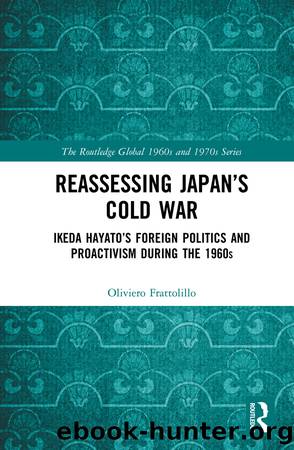Reassessing Japan's Cold War by Oliviero Frattolillo

Author:Oliviero Frattolillo [Frattolillo, Oliviero]
Language: eng
Format: epub
Tags: History, General, Asia, Japan, Military, World War II, United States, 20th Century
ISBN: 9780429938986
Google: dti_DwAAQBAJ
Publisher: Routledge
Published: 2019-11-22T15:58:19+00:00
3âJapanâs diplomatic role and the Konfrontasi
Indonesiaâs geopolitical centrality and Japan
In the first half of the 1960s, the geopolitical scenario in the Asian region was no less alarming than the European one. The Chinese question and the situation in both the Korean peninsula and the Indochinese area could not leave Japan indifferent. Tokyoâs response was to intensify its relationship with the non-Communist countries of South-East Asia, the Indian subcontinent, and the Middle East.
By the early 1960s, some of the countries that had recently achieved independence from colonial powers, together with the non-aligned countries, began to press the United Nations (UN) to include among its activities the promotion of development among poor countries and ensuring international economic equity. This position was formally articulated in 1960 at the UN General Assembly, where the request for more assistance to Developing Countries (DCs) from the ârichâ world was formally advanced. The success of the 1959 Communist revolution in Cuba, the ongoing crisis in Belgian Congo, and the inauguration of international aid politics by Communist China helped to foster awareness by Western countries of the strategic relevance of international assistance. In 1961, following the inauguration of the program known as a âDecade for Developmentâ (later to become the âFirst Decadeâ), industrialised countries were invited to devote 1% of their GDP to Official Development Assistance (ODA), in the forms of grant aid, soft loans, and Foreign Direct Investment (FDI).
At the first United Nations Conference on Trade and Development (UNCTAD I), held in Geneva in 1964 and attended by 77 Developing Countries (DCs) (âThe Group of 77â), Japan participated as a member of the ârich countriesâ (Group B). Having now reached the status of industrially advanced country, it made its first official commitment in the context of ODA, pledging to programmatically devote roughly 1% of its GDP to foreign aid resources. The Pearson Report, commissioned by the World Bank (WB) and published in 1969 by an international team led by Canadian Prime Minister Lester Pearson, was probably the policy paper that best represented the political spirit characterising the âDecade for Developmentâ. The report emphasised the need for the advanced countries to achieve the goal of allocating 1% of their GNP (with a minimum rate of 0.7% in the form of ODA) to the DCs by 1975.
The delicate fiscal and monetary problems that the US faced during the 1960s led Washington to shift part of the burden of financial aids to the other members of the âclub of rich countriesâ. The extraordinary economic growth that Japan was experiencing at that time did not allow it to escape from this commitment.1 Moreover, the imbalances of the US economy made urgent adjustment measures in JapanâAmerican relations Necessary. Washington pressed Tokyo to abandon its attitude towards the Ajia no hi-seijika (âde-politicization of Asiaâ)2 and to take a more active role in supporting anti-Communist forces in its own geopolitical area. Thus Japan set off a policy of intense aid flows to countries like Taiwan, South Korea, and Indonesia, and during a meeting between
Download
This site does not store any files on its server. We only index and link to content provided by other sites. Please contact the content providers to delete copyright contents if any and email us, we'll remove relevant links or contents immediately.
The Vikings: Conquering England, France, and Ireland by Wernick Robert(79167)
Ali Pasha, Lion of Ioannina by Eugenia Russell & Eugenia Russell(39927)
The Vikings: Discoverers of a New World by Wernick Robert(36828)
The Conquerors (The Winning of America Series Book 3) by Eckert Allan W(36700)
Cecilia; Or, Memoirs of an Heiress — Volume 1 by Fanny Burney(32068)
Cecilia; Or, Memoirs of an Heiress — Volume 3 by Fanny Burney(31463)
Cecilia; Or, Memoirs of an Heiress — Volume 2 by Fanny Burney(31413)
Empire of the Sikhs by Patwant Singh(22774)
Hans Sturm: A Soldier's Odyssey on the Eastern Front by Gordon Williamson(18332)
The Secret History by Donna Tartt(18198)
Cat's cradle by Kurt Vonnegut(14774)
Sapiens: A Brief History of Humankind by Yuval Noah Harari(13995)
Pimp by Iceberg Slim(13792)
Talking to Strangers by Malcolm Gladwell(12888)
Norse Mythology by Gaiman Neil(12848)
Leonardo da Vinci by Walter Isaacson(12810)
Underground: A Human History of the Worlds Beneath Our Feet by Will Hunt(11846)
4 3 2 1: A Novel by Paul Auster(11803)
The Radium Girls by Kate Moore(11632)
